Ivy: Ohh… worried, incoherent mumbling This one, no. This one. No. I don't know.
Posey: What are you doing Aunt Ivy?
Ivy: I was doing a spring clean. But now I can't remember where everything was and it all looks terrible.
Posey: There's an easy way to fix this.
Ivy: A time machine?
Posey: No. Put the ones that have the same characteristics together. So you can look after them easier. Plants fall into four categories: With seeds or without seeds; flowering plants, conifers, ferns and mosses.
Ivy: Four categories? So does that mean I have to do eenie-meenie-mini-mo?
Posey: You just have to look at their their features. Most of the flowers in your shop are flowering plants. You see? They use the flowers to reproduce and make baby versions of themselves. Trees are flowering plants too. They make fruit in the same way that smaller flowers do. The oak trees outside produce acorns.
Ivy: But how am I going to drag a tree in here? It's way too heavy and I'm only small.
Posey: It's ok. I think you can leave it out there.
Ivy: 'Leaf' it there. Hahaha. Good one.
Posey: Can you concentrate? The other plants which have seeds are conifers. But they don't flower. They're normally trees too but instead of leaves, they have needles and they keep their seeds safe inside a hard cone.
Ivy: Needle-less to say, they wouldn't fit in here either! Haha. I'm sorry, i'm concentrating.
Posey: But there are also some plants that don't produce seeds. Ferns and mosses. They both produce spores instead of flowers or cones.
Posey: Mosses don't look like flowering plants; they don't have a stem, or roots or leaves. They need to live in damp places.
Ivy: What about ferns?
Posey:Ferns have stems, leaves and roots but no flowers or seeds. The spores are released from their leaves. Why don't you group everything together now?
Ivy: Ok. So I have to group them according to their features. Right let's see… OK, all done. Though I think i'll leave my next spring clean till the spring. Cup of tea?
Posey: Yeah sure.
Video summary
An entertaining overview of how plants can easily be arranged according to their common features and characteristics.
For example: plants with seeds (e.g. flowering plants and conifers), or without seeds (e.g. ferns and mosses).
This is from the series: Ivy's plant shop.
Teacher Notes
You could bring in different variations of plants and get pupils to categorise them using the information highlighted in the film.
They could then choose one of the plants and make a poster labelling it's key characteristics.
This film will be relevant for teaching Science/Biology at Key Stage 1 and Key Stage 2 in England, Wales and Early and 1st and 2nd Level in Scotland.
Also at Foundation, KS1 and KS2 in Northern Ireland.
What do plants need to survive? video
A film looking at what plants need in order to survive.

The anatomy of the flower. video
A film looking at the various parts and functions of flowers.

Parts of a plant. video
A film looking at the various parts of a plant and their functions.

What is pollination and how does it work? video
A film looking at what pollination is and how it works.

Classifying and grouping plants. video
A film looking at different ways of classifying and grouping plants.

Grouping living things. video
A film looking at different ways of classifying and grouping living things.

Are plants the same all year round? video
A film looking at how plants adapt in order to deal with the different seasons of the year.

The impact deforestation has on plants and nature. video
A film looking at the impact deforestation has on plants and nature.

How can we protect plants and nature? video
A film looking at the ways we can all protect plants and nature.
